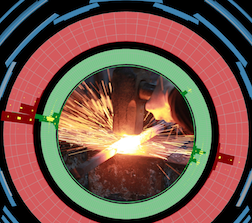Speaker
Description
Recently, it was shown that a canonical implementation of the type I seesaw mechanism in a warped extra dimensional framework is in reality a natural realization of ``inverse" seesaw, i.e., the SM neutrino mass is dominantly generated by exchange of pseudo-Dirac weak-scale SM singlet neutrinos. We study signals from production of these heavy singlet neutrinos at the LHC, using the elementary-composite site parametrization of this model.
The composite gauge symmetry is assumed to be $SU(2)_L \times SU(2)_R \times U(1)_X$, with singlet neutrino being part of a doublet of $SU(2)_R$, thus charged under $W_R$ and produced in its decays (similarly to 4D left-right (LR) symmetric models).
Naively, the direct coupling of light quarks to $W_R$ is negligible, because former is elementary, while latter is composite. However, due to almost degeneracy of mass of composite $W_L$ and $W_R$, we could obtain maximal mixing between these two after electro-weak symmetry breaking (EWSB), and thus on-shell production of $W_R$ at hadron colliders becomes feasible. Also, because of compositeness of the relevant particles, the dominant decay channel for $W_R$ involves the singlet neutrino and its $SU(2)_R$ doublet partner, i.e., a composite electron (instead of SM electron in 4D LR models). In turn, singlet neutrino can decay (as usual) into SM electron and W, while
the composite electron gives SM Higgs/Z and SM electron.
We show that a signal of large enough significance is possible at the 14 TeV LHC with 300 $\textrm{fb}^{-1}$ in the final states $l^{\pm} l^{\mp} j j H$ and $l^{\pm} l^{\mp} l^{\pm} H + \textrm{MET}$.
Furthermore, the singlet neutrino can also be pair produced via $Z^{ \prime }$ (the gauge boson of composite U(1) which is orthogonal to composite U(1)Y), following a similar mixing with composite Z from EWSB. Besides, it is possible that singlet neutrinos can come from decays of composite partners of $SU(2)_L$ doublet leptons, which are absent in the 4D LR case. These possibilities might become relevant for the even higher luminosity run of the LHC.
